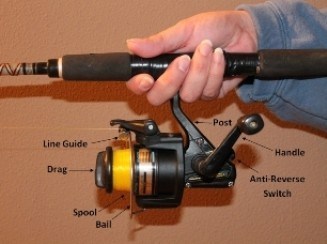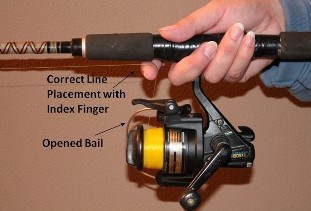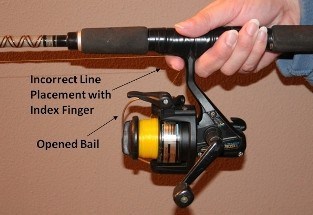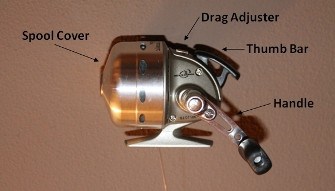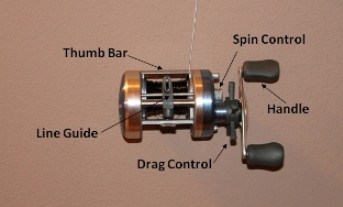Reels + Practice = Great Fishing!
Learn about casting and being good at it takes practice. However, once you know how to do it, it’s pretty easy. In time it will become natural. As you become more and more comfortable with one technique you will begin to start using different techniques to catch the type of fish you enjoy.
You can always practice in an open area on land before you go on the water. Attach a small object to your line, preferably something that does not have a hook or a sharp edge to avoid an injury.
Reels play an important part in this area of fishing. Therefore, I’m introducing you to reels in this section and how to cast with each specific reel. Our “Fishing Reel” section will introduce you to reels as well.
There are three types of reels to use, a spinning reel, a spin cast reel or a bait casting reel. For some reason I have become more and more comfortable using a spinning reel because it allows me to have more control in my techniques, but that’s just me.
Most beginners start with a spincast reel because it is so easy to use, especially for kids.
Depending on whether you are right-handed or left-handed determines how you will manage the fishing rod. Some people who are right-handed tend to cast with their right arm whereby retrieving their bait with their left hand. It really depends on how comfortable you are with casting. You should purchase your reel based on your comfort level in casting, except for spinning reels which allows you to change the handle from one side to another.
Reels are designed based on which hand you will use to reel in your catch. Most anglers tend to reel in their line using the hand they gravitate toward.
Before we go further into learning about the different types of reels it’s important to know which type of rod you should use based on the fish you want to catch because there a correlation between the two. Our “Fishtopia” section introduces you to various fish and their characteristics so that you can determine the type of fish you feel comfortable catching as well as the type of rod, fishing line and baits/lures to use. Our “Fishing Rod” section introduces you to various types of rods that are available for the type of fishing you will be enjoying.
If you haven’t already reviewed those sections, please take a moment now and come back to this section.
There are a few parts to a reel you should familiarize yourself with. For this example, I will be using a Spinning Reel.
This reel is designed to give you control in where you place the baits or lures you cast. This is why I like using a spinning reel. When I cast my baits or lures I like to be able to stop the bait or lure in mid-air so that I’m place the bait or lure exactly where I want it in the water. I have a tendency to over cast or sometimes the wind takes the bait or lure further then where I planned to place it. Being able to control the cast length ensures great placement in the water.
You would use a Spinning Reel when you are fishing for any type of small fish, walleyes or just about any type of fish. Some angles use a spinning reel when they are fishing for large aggressive fish like muskies.
Here’s a really easy process to follow when casting with this type of reel.
First, with your index finger, pull the line up against the rod grip. Make sure you pull the line directly straight up. The is the correct line placement.
Do not pull it towards the reel post. This is the incorrect line placement. Next, open the bail arm. You are now ready to cast.
Determine where you want to place the lure, pick a targeted area like by the pier, outside the weed line, or by the pool of lily pads. Remember, cast above your head versus towards your left or right side. This will ensure that you do not hook anyone as you cast. Aim the tip of your rod toward the area you want to cast. Hold the base of the rod with your opposite hand.
Rapidly move the rod back over your head and quickly cast forward. Your rod will bend slightly. As the rod moves in front of you, release your index finger from the line. The key is to release your finger as your rod points toward your targeted area.
Once you release your finger and your lure/bait hits the water, the bail arm will click into position. I tend to click the bail arm during a cast if I need to control the lure. Sometimes I may over cast, this technique allows for control. It’s not fun when your bait hooks a tree.
You can now retrieve your lure/bait by following the “Land a Fish” section.
The next reel is the Spincast Reel.
Just like with the Spinning Reel, learning this technique with a Spincast Reel takes practice. Most beginners tend to learn on a spincast reel because there are fewer steps to follow.
First, hold the rod in front of you. Your lure/bait should be about four inches from the tip of the rod. Press down firmly on the release button (thumb bar) and hold it there.
Face the area you which to cast towards. Aim your rod toward your targeted area. Smoothly bend your arm at the elbow and raise your hand with the rod. Your rod will be bent back slightly by the weight of the lure/bait. Gently move the rod forward. As the lure/bait passes your eye level, release your thumb from the release button.
If the lure/bait landed right in front of you, you released your thumb from the release button too soon.
Once you hook a fish, you can now retrieve your fish by following the “Land a Fish” section.
The next reel is the Bait Casting Reel.
Just like with the Spinning Reel and the Spincast Reel, learning to cast with a Bait Casting Reel takes practice. There really isn’t much different with the techniques; the weight of the bait/lure pulls the line from the spool until it reaches your targeted area.
This type of reel is generally used by angles who fish for larger species like largemouth bass, northern pike and muskies.
Once you master using this type of reel, the accuracy of your casting and placement of your lure/bait improves. Using this reel requires a great deal of practice if you want to achieve those results.
If you’re fishing for fish larger than pan fish, this reel is also one of the recommended reels. Spinnerbaits, heavy jigs, crankbaits, and any top water lures are generally more effective when using this type of reel, because they are designed for power, accuracy and more line capacity. Fishing for large fish requires more cranking power and casting accuracy especially when using a heavy test line. Review our “Fishing Line” section to learn more about fishing lines.
Most experienced anglers have more than one type of reel as they generally fish for different types of species.
Learning to cast is relatively easy and comes with practice because casting is done slightly overhead – not directly overhead. Be careful to no injure anyone near you because you are not casting directly overhead.
When casting with a bait casting reel place your thumb on the thumbar and hold the spool from turning. Your thumb will act as a guide and a break by lightly riding on the spool and line to control it. (You should practice your thumb riding on the spool of the line.) This technique is sometimes called “feathering”.
Your index finger should be placed around the bottom hook of the rod’s reel seat. Set your lure/bait 6” from the tip of your rod. Hold your rod and reel so that the handles are facing upwards tilted slightly, that’s if you’re right-handed. If you are left-handed the handles should be facing downwards. The reel should stay this why throughout the cast.
You should not be gripping the rod tightly when you cast. Grip the rod tightly when you hook a fish.
Start by making short lob-type casting. Swing your whole arm. You should not be snapping your rod tip with your wrist. The reason you make shot lob-type casting is because you want the spool to start spinning slowly and evenly. Lob casting will do this. Snap casting will make the spool spin too fast from the beginning, which will cause a backlash.
When the lure hits the area you are aiming for, your thumb should be putting pressure on the spool so that you stop the lure.
The more you practice this casting technique, the more you’ll become more accurate at casting and controlling the reel.
Don’t get frustrated at the backlashing that can occur with your line. Sometimes this happens with my line. I then need to straighten out my line. Sometimes you need to cut the line and rethread your rod.
Once you hook a fish, you can now retrieve your fish by following the “Land a Fish”section.

